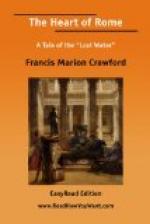Besides the general body of students and archaeologists, the Italian government was exceedingly interested in Malipieri’s explorations. The government is rightly jealous in such matters, and does its very best to keep all artistic objects of real value in the country. It is right that this should be so. The law relating to the matter was framed by Cardinal Pacca, under the papal administration many years ago, and the modern rulers have had the intelligence to maintain it and enforce it. Like other laws it is frequently broken. In this it resembles the Ten Commandments and most other rules framed by divine or human intelligence for the good of mankind and the advancement of civilization. The most sanguine lovers of their fellow-men have always admitted the existence of a certain number of flagitious persons who obstinately object to being good. David, who was hasty, included a large proportion of humanity amongst “the wicked”; Monsieur Drumont limited the number to David’s descendants; and Professor Lombroso, whatever he may really mean, conveys the impression that men of genius, criminals and lunatics are different manifestations of the same thing; as diamonds, charcoal and ham fat are all carbon and nothing else. We should be thankful for the small favours of providence in excepting us from the gifted minority of madmen, murderers and poets and making us just plain human beings, like other people.
There is no international law forbidding a man from making digressions when he is telling a story.
Malipieri was watched by the government, as Volterra had told him, because it was feared in high quarters that if he found anything of value under the palace, he would try to get it out of the country. He had always hated the government and had got himself into trouble by attacking the monarchy. Besides, it was known in high quarters that Senator Baron Volterra held singular views about the authenticity of works of art. It would be inconvenient to have a scandal in the Senate about the Velasquez and the other pictures; on the other hand, if anything more of the same sort should happen, it would be very convenient indeed to catch a pair of culprits in the shape of Malipieri, a pardoned political offender, and his ex-convict servant.
Then, too, in quite another direction, the Vatican was very anxious to buy any really good work of art which might be discovered, and would pay quite as much for it as the government itself. Therefore the Vatican was profoundly interested in Malipieri on its own account.
As if this were not enough, Sabina’s brother, the ruined Prince Conti, had got wind of the excavations and scented some possible advantage to himself, with the vague chance of more money to throw away on automobiles, at Monte Carlo, and in the company of a cosmopolitan young person of semi-Oriental extraction whose varied accomplishments had made her the talk of Europe.




